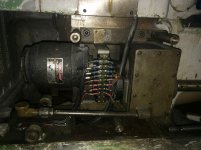Need a drive to control a "Universal" motor in a lathe I am rebuilding (feed motor, drives a reduction gearbox).
Would like the motor to have variable speed (will use outboard potentiometer to control the drive) and excellent regulation of speed.
Assuming the price is the same, is there any reason to prefer a VFD vs a DC drive for a universal motor?
May not even need a DC drive - unless you need tight regulation under
varying load. That isn't really a Series/Universal wound motor's best use, but it can work. Series-wound can deliver a lot of power, but run "naked" they expect to be
allowed to speed-up or slow down to match the load. Shunt-wound OTOH, try hard to self-regulate.
Variac's work fine for my "Precise" grinders. Not much change to their load once the wheel is in contact.
"Classical" VFD aren't an option, ordinarily. Single-phase motor, even if AC/DC-friendly.
There are some newer approaches finding their way into cordless power tools. No idea how suitable those might be for your application, torque & RPM-wise. Our PM meber Mattij in Finland may be able to assist. I'm not current, nor expect to be.
I think the greatest barrier is that they are engineered as a complete "system' and may be difficult to re-purpose as severed components for onesies or fewsies.
Another option is a fractional HP DC gearmotor. Some are around as reasonably priced NOS, not ever used. I have a Bison I've tested and set aside for the tiny Burke #4 mill. Bodine, I've always liked even better.
As to "excellent regulation"? See the percentage figures on DC drive pubs. Inherent Armature feedback, onboard reference source, biased op amp for comparator, and it ain't half bad. Add an Analog tacho, and the CLAIMS at least are seriously better.
These want an old-school analog tachogenerator, not because resolvers aren't generally better, if not also cheaper, long-term, but because nearly all the economical DC Drives have inputs to utilize Analog tacho, but few have inputs for Digital.
Not really a "cheat" but for the most part, they just jumper or switch the lead that WAS tapping the Armature output off to a terminal for the Tacho input, set other switches or jumpers to a resistive array that selects the Volts per 1,000 RPM expected. Not lot of extra parts involved to make analog tacho control possible, IOW.
For a digital pulse stream there are cheap IC's for conversion, frequency from the pulse train to Voltage level ramped - I have several type around.
OTOH, it's a R-PITA to build, calibrate,
keep in calibration, when a ServoTek tachogenerator is only about $25-$120 used, and probably $300, new -depending on space available and mounting options.
Small size?
You can probably find very affordable servo motors and kit to operate them.
I'd go there rather than mess with a universal wound motor on any sort of lathe traverse drive system. MUCH easier to nail the stability issue reliably.
Otherwise? The Series type motor is not always supported by inexpensive DC Drives anyway. Shunt wound essentially always is, PM or wound field, brushless or brushed.



